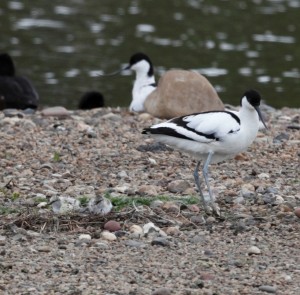Returning avocets set new wildlife record
A bird which made local wildlife history when it hatched chicks at WWT Washington for the very first time has broken yet another record.

Four pairs of avocet have nested and successfully hatched chicks at the wildlife reserve’s Wader Lake this breeding season, producing a bumper 12 young between them.
But for the first time in the site’s 38-year history, two of the striking black and white waders have made return journeys to breed at WWT Washington, after hatching here themselves in 2011.
The two adults – which formed separate pairs – were identified by their colour rings; put on their legs as small chicks by the British Trust for Ornithology (BTO) and used to help track their movements.
This provides experts with vital information such as what is happening to birds in the places they live and how this affects population increases and decreases.
John Gowland, WWT Washington’s reserve manager, said: “This is a fantastic first for our site and clearly demonstrates the importance of species tracking and research, which provides vital information for future conservation. It also highlights the importance of wetland habitat in supporting and encouraging rare wildlife.
“One of the avocets has a light green over blue rings on its left leg and dark green over white on its right leg, which shows that it was ringed here at Washington on 2/6/2011; while the second has the same left leg, with dark green over black on the right leg, showing that it was ringed at Washington on 23/5/2011.
“Avocets are a migratory species and in the past, we’ve also had confirmation that an avocet ringed here in 2010 ended up in Cadiz, in Spain, although it hasn’t returned to Washington as yet. So our 2011 birds may well have been to Spain themselves or even somewhere as far away as Africa.”
Avocets first nested at WWT Washington in 2006 and hatched two chicks that July, the most northerly UK hatching ever recorded at that time.
They have bred successfully every season since, and in April 2010 a second pair briefly appeared on the water but was soon chased off by the territorial original residents, which were already nesting. In 2011, two pairs settled and produced young, while last year four pairs nested for the first time and fledged three chicks in total.
John added: “Our staff and volunteers work very hard to maintain Wader Lake, where the avocets nest, so that it is attractive to wading birds. For example, by creating mudflats rich in invertebrates for them to feed on and by suppressing vegetation on the islands where they build their nests using recycled Astroturf, to produce better potential nesting sites.
“The avocets were late arriving back this year and at one point we did have a record five pairs in total, but only four went on to successfully nest, which was disappointing. However, when we discovered that two of the returning birds had been ringed here originally, we were ecstatic!
“Providing they have a successful nest, avocets do become loyal to the same site for their entire lives, so hopefully the two returning birds and their partners will fledge healthy chicks and continue returning to WWT Washington for many years to come.
The avocet was declared extinct as a breeding bird in the UK in 1842 but began to recover in 1947, colonising areas of wetland on the south and east coasts of England. Until their arrival at WWT Washington in 2006, the nearest breeding pairs were in Teesside and Yorkshire, with fewer than 900 pairs in the UK. In May 2011, two chicks hatched at Northumberland Wildlife Trust’s Cresswell Pond reserve, making it the UK’s most northerly breeding site.
The distinctive waders, with their elegant upwardly-curving beaks, are particularly renowned for their unique behaviour when, after copulation, the male puts one wing around the female and they run forward together with their bills crossed.
Visitors can watch the avocets from the four hides at Wader Lake and also via CCTV from Waterside Cafe.
Did you know?...
There are four species of avocet within the genus Recurvirostra – the pied, the American, the Andean and the Red-necked.
The avocets at WWT Washington are pied avocets or Recurvirostra avosetta, which translates as “with beak bent back”.
Pied avocets are striking black and white waders with a distinctive and melodious kluit kluit call.
They breed in temperate Europe and western and Central Asia. They are a migratory species and most winter in Africa or southern Asia. Some remain to winter in the mildest parts of their range, for example in southern Spain and southern England.
Avocets nest in shallow scrape lined with short pieces of stem, roots and leaves of marsh vegetation. Clutches are usually of three to four eggs, with incubation taking 23 to 25 days. The fledgling period is 35 to 42 days.
Avocets swim and up-end like ducks to catch prey in their unusually curved beak; feeding on aquatic insects, larvae, crustaceans and worms. The scything motion of their bills when foraging, moving side to side in the water, is a feeding technique unique to avocets.
The avocet is a Schedule 1 protected species and anybody convicted of taking, injuring or killing an avocet or damaging its nest, eggs or young faces a fine of up to £5,000 and/or six months in prison.
The avocet also features on the Amber List of UK birds of conservation concern, due to its localised distribution in Britain and elsewhere in Europe.
For more information about bird ringing, please visit the British Trust for Ornithology website at http://www.bto.org
For more information about research and monitoring projects carried out by the Wildfowl & Wetlands Trust please visit http://www.wwt.org.uk/conservation/saving-wetlands-and-wildlife/saving-wildlife/



